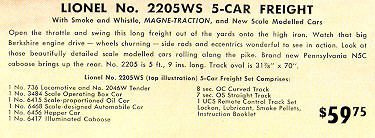Scale Or Tinplate
by Joseph H. Lechner
During Lionel’s postwar heyday, there was no clear distinction between toy trains and model railroads.
Today, most folks use the word tinplate when referring to toy trains made by Lionel, IVES, American Flyer and the like. Tinplate is steel that has been coated with tin to protect against rusting. Most prewar toy trains were built from stamped sheet metal, so the term tinplate eventually came to mean toys made of that material. The tubular track used for O gauge, S gauge and standard gauge trains is still made of tinplate today. Postwar trains that run on those tracks are called tinplate too, although nearly all of them are made of die-cast metal and plastic.
Louis H. Hertz, who is better known for his books on toy train collecting, also wrote “The Complete Book of Model Railroading” (1951: Simmons-Boardman Publishing Corporation). In it, he distinguished between scale and tinplate, but not in the same way most hobbyists do today. Tinplate for Hertz meant ready-made equipment sold by companies that were primarily engaged in the toy business (even if a significant portion of their products were used by adults). Scale meant a model that was assembled from a kit or built from scratch. While the original motivation for building a scale model was to achieve greater realism than possible with tinplate, the boundaries soon became blurred. Hertz contended that much of the tinplate available at mid-century was as well proportioned as scale equipment.
In 1953, Lionel began using the term “scale proportioned” to describe its new 6415 tank car, #6464 box cars, #6468 automobile car, #6511 flat car, and the #6417 N5c caboose (see Figure 2). Other “scale” adjectives used in catalog copy included “scale modeled” (see Figure 3), “scale designed” (see Figure 4), “scale detailed” (see Figure 5), and “scale length” (see Figure 6). Those items were still tinplate according to Hertz’s definition, but then so are the exquisite HO and N trains made by Bachmann, Life-Like and Kato today.
Louis Hertz regarded tinplate operators and scale enthusiasts alike as “model railroaders”. He wrote, “There is no onus associated with operating a system with tinplate equipment rather than… scale models… Tinplate and tinplaters, far from being terms of disparagement… are honored words in model railroad phraseology.”
Throughout his book, Hertz showed examples of scenicked model railroad systems that were realistically operated by their owners. Tinplate and scale equipment appeared on an equal footing. There were photos from John Allen’s HO “Gorre & Daphetid” and from Frank Ellison’s O gauge “Delta Lines”-two of the most renowned scale model railroads of that day-but there were also layouts featuring the standard gauge products of Lionel, American Flyer and Ives, and prewar Lionel O.
Standard gauge layouts of that era strove for realism: closely spaced parallel tracks, scratchbuilt signals, lichen trees, painted backdrops. A pike by Hugh Newsom featured towering mountain scenery that extended at least 30″ above eye level, a convincing alpine glacier, and forced-perspective structures in the distance. A standard gauge scene by Walter Bellis showed a long freight train on a graceful “S” curve, appropriately sized-vehicles, and telephone poles with individually strung wires. The builders of these layouts had assembled working miniature railroads from the mass-produced equipment that was available to them during the 1930s. They used tinplate equipment to re-create what they saw on prototype railroads. In contrast, many of today’s standard gauge layouts seem to re-create store displays where those toys were sold seventy or more years ago. Not that there’s anything wrong with that; the emphasis is just different today.
Louis Hertz saw no contradiction in presenting scale and tinplate side-by-side as examples of model railroading. He showed imported brass locomotives and scratchbuilt interurbans, but he also showed Lionel’s 2330, 2343 and 773 as representatives of electric, diesel and steam power. He discussed hand-laying two-rail track, but he also explained how to wire block signals for three-rail track, and how 022 switches could be interconnected to achieve automatic train routing.
Likewise, at mid-century, The Lionel Corporation didn’t just sell toy trains; it sold “model railroading”. Postwar catalog illustrations rarely showed benchwork, control panels, or human operators; and they never showed the package the equipment came in. In these wishbooks, we saw railroads climbing mountains and crossing rivers to deliver freight and passengers to their destinations. Catalogs showed ultimate realism, then explained how to achieve it using Lionel equipment.
The message of Louis Hertz’s book, and of Lionel’s postwar catalogs, was clear: toy trains were made for model railroading.
Lionel® is a registered trademark and is used with the permission of Lionel® L.L.C. Copies of Lionel® copyrighted materials have been used in this publication with the permission of Lionel® L.L.C.”













